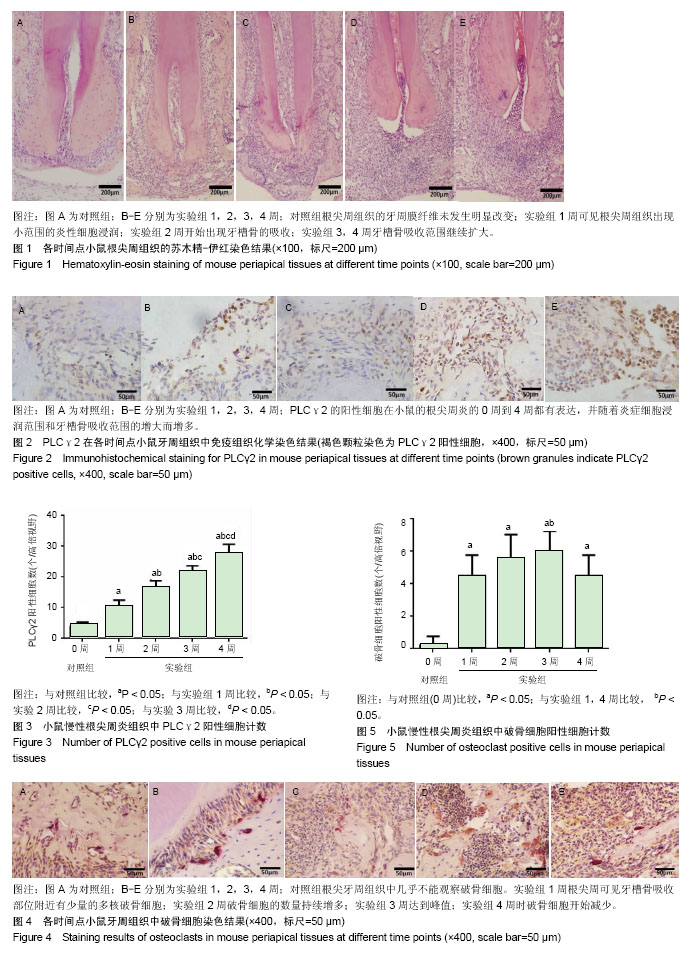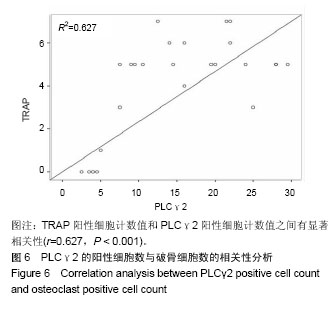中国组织工程研究 ›› 2019, Vol. 23 ›› Issue (7): 1057-1062.doi: 10.3969/j.issn.2095-4344.1023
• 组织构建实验造模 experimental modeling in tissue construction • 上一篇 下一篇
野生型小鼠慢性根尖周炎模型PLCγ2的表达
杨淳贺,仉 红,董 明,王丽娜,牛卫东
- (大连医科大学口腔医学院牙体牙髓教研室,辽宁省大连市 116041)
Expression of PLCgamma2 in a wild-type mouse model of chronic periapical periodontitis
Yang Chunhe, Zhang Hong, Dong Ming, Wang Lina, Niu Weidong
- (Department of Endodontology, School of Stomatology, Dalian Medical University, Dalian 116041, Liaoning Province, China)
摘要:
文章快速阅读:
.jpg) 文题释义:
PLCγ2:全称Phospholipase Cγ2,是一种磷脂酶,参与了生物体的许多生理病理过程,包括细胞增殖和分化、调节细胞骨架、细胞凋亡、肿瘤的迁移,同时其在免疫细胞和破骨细胞的形成过程中也发挥了不同的作用。PLCγ2通过一系列反应激活钙离子(Ca2+)信号通路,调节破骨细胞的生成。
慢性根尖周炎:是由多种细菌及毒力因子入侵根尖周组织,引起根尖组织炎症性反应,以根尖区的牙槽骨吸收为主要特征的一类疾病,是多种细胞因子共同参与的结果。
文题释义:
PLCγ2:全称Phospholipase Cγ2,是一种磷脂酶,参与了生物体的许多生理病理过程,包括细胞增殖和分化、调节细胞骨架、细胞凋亡、肿瘤的迁移,同时其在免疫细胞和破骨细胞的形成过程中也发挥了不同的作用。PLCγ2通过一系列反应激活钙离子(Ca2+)信号通路,调节破骨细胞的生成。
慢性根尖周炎:是由多种细菌及毒力因子入侵根尖周组织,引起根尖组织炎症性反应,以根尖区的牙槽骨吸收为主要特征的一类疾病,是多种细胞因子共同参与的结果。
.jpg) 文题释义:
PLCγ2:全称Phospholipase Cγ2,是一种磷脂酶,参与了生物体的许多生理病理过程,包括细胞增殖和分化、调节细胞骨架、细胞凋亡、肿瘤的迁移,同时其在免疫细胞和破骨细胞的形成过程中也发挥了不同的作用。PLCγ2通过一系列反应激活钙离子(Ca2+)信号通路,调节破骨细胞的生成。
慢性根尖周炎:是由多种细菌及毒力因子入侵根尖周组织,引起根尖组织炎症性反应,以根尖区的牙槽骨吸收为主要特征的一类疾病,是多种细胞因子共同参与的结果。
文题释义:
PLCγ2:全称Phospholipase Cγ2,是一种磷脂酶,参与了生物体的许多生理病理过程,包括细胞增殖和分化、调节细胞骨架、细胞凋亡、肿瘤的迁移,同时其在免疫细胞和破骨细胞的形成过程中也发挥了不同的作用。PLCγ2通过一系列反应激活钙离子(Ca2+)信号通路,调节破骨细胞的生成。
慢性根尖周炎:是由多种细菌及毒力因子入侵根尖周组织,引起根尖组织炎症性反应,以根尖区的牙槽骨吸收为主要特征的一类疾病,是多种细胞因子共同参与的结果。摘要
背景:研究表明,抑制BTK-PLCγ2- Ca2+信号通路,破骨细胞的形成和功能受到抑制,说明PLCγ2参与了破骨细胞的形成和分化。
目的:通过建立野生型小鼠慢性根尖周炎模型,观察PLCγ2在小鼠实验性根尖周炎组织中的表达。
方法:选用20只C57BL/6L野生型雄性小鼠,随机选取16只为实验组行双侧下颌第1磨牙开髓术,并将开髓后的髓腔暴露于口腔环境,诱导形成根尖周炎病损。分别于开髓后1,2,3和4周各随机处死4只小鼠,分离下颌骨。剩余4只不开髓作为空白对照,0周时处死后分离下颌骨。制作冰冻切片后用苏木精-伊红染色方法观察小鼠根尖组织炎症情况,免疫组织化学染色检测PLCγ2的表达与分布情况,酶组织化学染色检测根尖组织炎症区域破骨细胞的表达。
结果与结论:①苏木精-伊红染色结果:对照组小鼠下颌第1磨牙牙周组织几乎无炎性细胞浸润;实验组1-4周,下颌第1磨牙牙周组织炎性细胞浸润范围越来越大,牙槽骨破坏也逐渐增多,说明成功建立了小鼠根尖周炎模型;②免疫组织化学染色结果:发现PLCγ2在小鼠根尖周炎的0-4周都有表达;对照组根尖周组织中仅有少量PLCγ2的表达;实验组1-4周PLCγ2阳性表达随炎症细胞浸润范围的逐渐扩大而增长(P < 0.05);③TRAP染色结果:对照组根尖牙周组织中几乎不能观察到破骨细胞;实验组1周,可观察到少量的多核破骨细胞;实验组2周,破骨细胞的数量持续增多;实验组3周达到峰值;实验组4周破骨细胞数量逐渐减少;与对照组相比差异均有显著性意义(P < 0.05);④相关性分析:TRAP阳性细胞计数值和PLCγ2阳性细胞计数之间有显著相关性(r=0.627,P < 0.001);⑤结果说明,PLCγ2在小鼠根尖周组织中有表达,提示其可能与根尖周炎症反应和骨吸收作用相关。
中国组织工程研究杂志出版内容重点:组织构建;骨细胞;软骨细胞;细胞培养;成纤维细胞;血管内皮细胞;骨质疏松;组织工程
ORCID: 0000-0002-8786-7656(杨淳贺)
中图分类号:


.jpg) 文题释义:
PLCγ2:全称Phospholipase Cγ2,是一种磷脂酶,参与了生物体的许多生理病理过程,包括细胞增殖和分化、调节细胞骨架、细胞凋亡、肿瘤的迁移,同时其在免疫细胞和破骨细胞的形成过程中也发挥了不同的作用。PLCγ2通过一系列反应激活钙离子(Ca2+)信号通路,调节破骨细胞的生成。
慢性根尖周炎:是由多种细菌及毒力因子入侵根尖周组织,引起根尖组织炎症性反应,以根尖区的牙槽骨吸收为主要特征的一类疾病,是多种细胞因子共同参与的结果。
文题释义:
PLCγ2:全称Phospholipase Cγ2,是一种磷脂酶,参与了生物体的许多生理病理过程,包括细胞增殖和分化、调节细胞骨架、细胞凋亡、肿瘤的迁移,同时其在免疫细胞和破骨细胞的形成过程中也发挥了不同的作用。PLCγ2通过一系列反应激活钙离子(Ca2+)信号通路,调节破骨细胞的生成。
慢性根尖周炎:是由多种细菌及毒力因子入侵根尖周组织,引起根尖组织炎症性反应,以根尖区的牙槽骨吸收为主要特征的一类疾病,是多种细胞因子共同参与的结果。